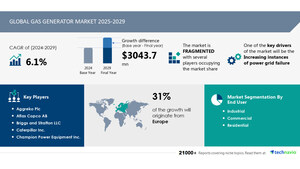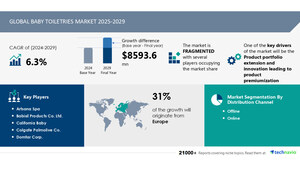NEW YORK, May 2, 2024 /PRNewswire/ --The global aviation fuel market size is estimated to grow by USD 93.88 billion from 2023 to 2027, according to Technavio. This growth is expected to occur at a Compound Annual Growth Rate (CAGR) of 8% during the forecast period.
To understand more about this market- Download a FREE Sample Report in minutes!
Key Trends Fueling Growth
- Launch of new aviation fuel technology:
- Vendors in the targeted market have introduced novel fuel technologies to enhance sustainability in aviation. For instance, in March 2023, Honeywell unveiled its UOP eFining technology, designed to produce low-carbon sustainable aviation fuel (SAF). These electrofuels offer an alternative to traditional fossil fuels, promising reduced environmental impact.
- Similarly, in October 2022, Honeywell rolled out an innovative ethanol-to-jet fuel (ETJ) processing technology. This advancement enables the conversion of ethanol derived from corn, cellulosic, or sugar-based sources into SAF. These launches signify a significant step towards advancing the market's growth trajectory in the foreseeable future.
- By offering solutions that address environmental concerns and align with sustainability goals, these technologies are poised to drive market expansion in the coming years.
For insights on the market trends with forecast market size and historic data (2017 - 2021)- Download a FREE Sample Report in minutes!
Major Challenges:
- Fluctuations in oil and gas prices
- The aviation sector's fortunes are tightly tethered to crude oil prices. Since mid-2014, oil prices have remained low due to an imbalance in supply and demand. This decline hit upstream oil and gas companies hard, slashing revenues as crude prices plummeted from $110 per barrel in June 2014 to just $35 per barrel by January 2020. However, downstream players benefited from cheaper crude, leading to reduced operating costs and fatter profit margins.
- For airlines, volatile oil prices pose a significant risk, as higher crude costs inflate aviation fuel expenses. Yet, during periods of low oil prices, airlines reap the rewards with boosted profits and slashed airfares, spurring increased demand for air travel. This surge in demand prompts airlines to expand their routes or fleet, potentially compromising profitability when oil prices rebound.
- Consequently, investment in alternative aviation fuels has taken a back seat. Airlines face a delicate balancing act, leveraging low aviation fuel costs while cautiously expanding capacity to navigate through crude oil price fluctuations, which could impede market growth in the foreseeable future.
To know more about the market opportunities impacted by market dynamics, click here to- Download a FREE Sample Report in minutes!
Analyst Review
The aviation fuel market encompasses a wide array of elements, including aviation turbine fuel and aviation gasoline, catering to various sectors such as commercial, defense, and general aviation. With the global population increasing, the consumption of aviation fuel is on the rise, driving technological advancements and research efforts in biofuels. Regulatory bodies play a crucial role in ensuring compatibility with existing aircraft while promoting efficiency and scalability of production.
Investments in infrastructure, refining facilities, and feedstock cultivation are pivotal for future growth. Environmental regulations are shaping the landscape, prompting aircraft manufacturers to develop efficient and aerodynamic aircraft, including electric options. Strategic mergers aim to reduce operating expenses and expand the customer base, while green and sustainable fuel solutions gain traction.
Market dynamics include considerations of reduced fuel costs, energy content, configurations, and types, all influencing revenue generation. Innovation in aircraft production, driven by disposable income and living standards, results in innovative designs and efficient engines to meet the demands of modern air travel.
Market Overview
The aviation fuel market is seeing notable shifts due to various factors. With commercial and defense aviation sectors expanding, there's a heightened focus on reducing greenhouse gas emissions. One key concern is the risks of icing, particularly for short-distance travel where flying routes are concentrated. To address this, the industry is pushing for more efficient aircraft designs to lower fuel consumption.
Electric aircraft are gaining attention for their potential to mitigate environmental impact and reduce reliance on conventional-fueled aircraft. As a result, the aviation fuel market share is evolving, with a growing interest in alternatives that promise reduced fuel costs. Balancing these considerations is crucial for meeting both economic and environmental objectives in the aviation sector, ensuring sustainable growth while minimizing adverse impacts.
To understand more about this market report- Download a FREE Sample Report in minutes!
Key Topics Covered:
1 Executive Summary
2 Market Landscape
3 Market Sizing
4 Historic Market Size
5 Five Forces Analysis
6 Market Segmentation
7 Customer Landscape
- End-user
- Commercial
- Military
- Private
- Product
- ATF
- Aviation Biofuel
- Geography
- North America
- APAC
- Europe
- South America
- Middle East And Africa
8 Geographic Landscape
9 Drivers, Challenges, and Trends
10 Vendor Landscape
11 Vendor Analysis
12 Appendix
About Technavio
Technavio is a leading global technology research and advisory company. Their research and analysis focuses on emerging market trends and provides actionable insights to help businesses identify market opportunities and develop effective strategies to optimize their market positions.
With over 500 specialized analysts, Technavio's report library consists of more than 17,000 reports and counting, covering 800 technologies, spanning across 50 countries. Their client base consists of enterprises of all sizes, including more than 100 Fortune 500 companies. This growing client base relies on Technavio's comprehensive coverage, extensive research, and actionable market insights to identify opportunities in existing and potential markets and assess their competitive positions within changing market scenarios.
Contacts
Technavio Research
Jesse Maida
Media & Marketing Executive
US: +1 844 364 1100
UK: +44 203 893 3200
Email: [email protected]
Website: www.technavio.com/
SOURCE Technavio

WANT YOUR COMPANY'S NEWS FEATURED ON PRNEWSWIRE.COM?
Newsrooms &
Influencers
Digital Media
Outlets
Journalists
Opted In






Share this article